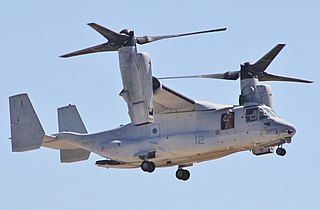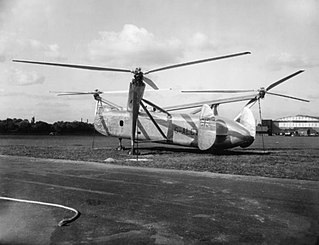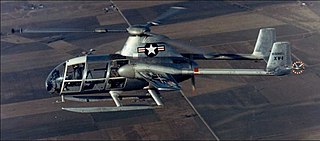Bratukhin, or OKB-3, was a Soviet aircraft design bureau created in 1940 from within TsAGI to develop helicopters. Headed by Ivan Pavlovich Bratukhin, the bureau built several experimental helicopters over the next decade. Each model had the same basic design of two rotors with separate engines carried on the ends of outriggers to each side of the fuselage. The bureau was dissolved in 1951.
Original prototype helicopter with two 164 kW engines mounted at the end of outriggers.
Bratukhin Omega II
Improved version of the Omega, with 261 kW engines and structural strengthening. One example produced, which was flown to an altitude of 3000m in January 1945 and used thereafter for pilot training.
Bratukhin G-3
Similar to the Omega II, but powered by 336 kW Pratt & Whitney R-985 Wasp Juniors. Two prototypes were followed by five production aircraft. Four were used for research and one for pilot training.
Bratukhin G-4
Similar to the original Omega, but powered by 373 kW Ivchenko AI-26GR engines. Two prototypes and four production aircraft built.
Improved and larger design completed in 1947. Powered by improved AI-26 engines developing 410 kW. Only brief hops were made due to structural problems.
Bratukhin B-9
Similar to B-5 with fuselage designed for air ambulance use. Cancelled after failure of B-5
Bratukhin B-10
Similar in configuration to B-5, with uprated AI-26 engines of 429 kW. Fuselage designed for use in artillery observation role. Flown in 1947 but ultimately abandoned.
The last of Bratukhin's helicopters. Generally similar to B-5 with an improved rotor system. Two prototypes produced. One lost in fatal accident on 13 December 1948.

The Fairey Rotodyne was a 1950s British compound gyroplane designed and built by Fairey Aviation and intended for commercial and military uses. A development of the earlier Gyrodyne, which had established a world helicopter speed record, the Rotodyne featured a tip-jet-powered rotor that burned a mixture of fuel and compressed air bled from two wing-mounted Napier Eland turboprops. The rotor was driven for vertical takeoffs, landings and hovering, as well as low-speed translational flight, but autorotated during cruise flight with all engine power applied to two propellers.

The Bell XV-15 is an American tiltrotor VTOL aircraft. It was the second successful experimental tiltrotor aircraft and the first to demonstrate the concept's high speed performance relative to conventional helicopters.

The Yakovlev Yak-24 is a Soviet twin-engine, tandem rotor, transport helicopter developed by Yakovlev in the 1950s. The Yak-24 saw limited use in the Soviet Air Force, and the exact number produced and duration of service are unknown due to inconsistencies in data.

The Mil Mi-1 was a Soviet three- or four-seat light utility helicopter. It was the first Soviet helicopter to enter serial production. It is powered by one 575 hp (429 kW) Ivchenko AI-26V radial. It entered service in 1950 and was first seen on the 1951 Soviet Aviation Day, Tushino and was produced for 16 years. More than 1,000 were built in the USSR and 1,594 in Poland, as SM-1.

The Focke-Achgelis Fa 223 Drache was a helicopter developed by Germany during World War II. A single 750-kilowatt (1,010 hp) Bramo 323 radial engine powered two three-bladed 11.9-metre (39 ft) rotors mounted on twin booms on either side of the 12.2-metre-long (40 ft) cylindrical fuselage. Although the Fa 223 is noted for being the first helicopter to attain production status, production of the helicopter was hampered by Allied bombing of the factory, and only 20 were built.

A tip jet is a jet nozzle at the tip of some helicopter rotor blades, used to spin the rotor, much like a Catherine wheel firework. Tip jets replace the normal shaft drive and have the advantage of placing no torque on the airframe, thus not requiring the presence of a tail rotor. Some simple monocopters are composed of nothing but a single blade with a tip rocket.
A convertiplane is defined by the Fédération Aéronautique Internationale as an aircraft which uses rotor power for vertical takeoff and landing (VTOL) and converts to fixed-wing lift in normal flight. In the US it is further classified as a sub-type of powered lift. In popular usage it sometimes includes any aircraft that converts in flight to change its method of obtaining lift.

The Bristol Type 173 was a British twin-engine, tandem rotor transport helicopter built by the Bristol Aeroplane Company. It was designed by Raoul Hafner as a civil transport helicopter but evoked interest from the military. It did not enter production but was developed into the Bristol Belvedere which was operated by the Royal Air Force from 1961 to 1969.

A powered lift aircraft takes off and lands vertically under engine power but uses a fixed wing for horizontal flight. Like helicopters, these aircraft do not need a long runway to take off and land, but they have a speed and performance similar to standard fixed-wing aircraft in combat or other situations.

The Westland Westminster was a British helicopter of the 1950s from Westland Aircraft. A large cargo design, it was powered by two turboshaft engines driving a single, five-bladed rotor. Initially unclad, the all-metal airframe was later enclosed in a fabric covering. Designed and built as a private venture without government assistance, it was cancelled when Westland took over rival helicopter producers and their more advanced projects.

The Cierva W.11 Air Horse was a helicopter developed by the Cierva Autogiro Company in the United Kingdom during the mid-1940s. The largest helicopter in the world at the time of its debut, the Air Horse was unusual for using three rotors mounted on outriggers, and driven by a single engine mounted inside the fuselage.

The Boeing Vertol XCH-62 was a triple-turbine, heavy-lift helicopter project designed for the United States Army by Boeing Vertol. Approved in 1971, one prototype reached 95% completion before it was canceled in 1975. The prototype was scrapped in 2005.

The Sikorsky S-60 helicopter, a prototype "flying crane", was derived from the S-56 in 1958. Proving to be underpowered, the development of the S-60 led to the larger, turbine-engined Sikorsky CH-54 Tarhe military transport helicopter, and its civil S-64 Skycrane variant, which were already on the drawing board by the time the sole example of the S-60 crashed on 3 April 1961.

The Bratukhin Omega was an early Soviet helicopter, the first product of a new Soviet design bureau, OKB-3 that was created from within TsAGI specifically to develop rotary-wing aircraft. Bratukhin's design was a side-by-side twin rotor machine, with each rotor carried on a long outrigger truss. The Omega's rotors were each powered by a separate engine carried in a nacelle also at the end of the truss. Captive trials commenced in August 1941 and revealed severe problems with engine vibration and overheating. Before these could be addressed, however, OKB-3 was evacuated ahead of the German advance into the Soviet Union.

The McDonnell XV-1 is an experimental Convertiplane developed by McDonnell Aircraft for a joint research program between the United States Air Force and the United States Army to explore technologies to develop an aircraft that could take off and land like a helicopter but fly at faster airspeeds, similar to a conventional airplane. The XV-1 would reach a speed of 200 mph, faster than any previous rotorcraft, but the program was terminated due to the tip-jet noise and complexity of the technology which gave only a modest gain in performance.

The Bell Huey family of helicopters includes a wide range of civil and military aircraft produced since 1956 by Bell Helicopter. This H-1 family of aircraft includes the utility UH-1 Iroquois and the derivative AH-1 Cobra attack helicopter series and ranges from the XH-40 prototype, first flown in October 1956 to the 21st-century UH-1Y Venom and AH-1Z Viper.

The Bratukhin B-11 was a prototype Soviet twin-rotor transport helicopter and the last design of the Bratukhin aircraft design bureau to be built.
The Bratukhin B-5 was a prototype Soviet twin-rotor transport helicopter designed by the Bratukhin aircraft design bureau.

The Dornier Do 32E was a simple, collapsible one-man helicopter, designed for military use in Germany in the 1960s. Despite initial hopes of large orders and some proposed civilian roles, only three flew.
The Omega BS-12 was a utility helicopter with high ground clearance designed to carry loads behind the cabin at, or near, the center of gravity.
{{cite journal}}: Cite journal requires |journal= (help)